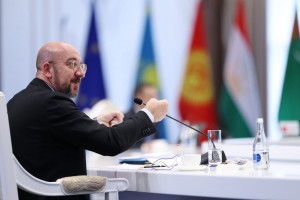 The EU is pushing a new strategy to challenge growing Chinese influence in Central Asia.
The EU is pushing a new strategy to challenge growing Chinese influence in Central Asia.
Central Asia is becoming a magnet for global powers. Given its advantage of geographical proximity, China is increasing its influence in the region with promises of mega projects. The European Union (EU), on the other hand, aims to strengthen its presence in the region and to reduce Chinese influence with a new strategy.
China’s approach to Central Asia is characterized by huge, long-term investments based on Chinese loans that can be challenging to pay off (the so-called debt-trap diplomacy.) The fate of many projects that China has committed to finish is uncertain.
Debt-trap diplomacy has left countries like Kyrgyzstan and Tajikistan owing close to half their sovereign debt to China and have sparked over 150 protests linked to this burden. The EU instead offers loans designed to accelerate economic transformation, adaptation to a free-market economy and promotion of human rights. This “Western” agenda too has its critics.
In 2007, the EU formalized its approach with the first Central Asia Strategy Paper. Despite this initiative, the US prioritization of Afghanistan in its regional policies has led the EU to consider the region mostly in the context of securityand focusing on developments in that country.
This has created an opportunity for China to expand its influence. Since the announcement of the Belt and Road Initiative (BRI) by Xi Jinping in 2013, China has invested heavily in Central Asian countries, solidifying its position as a major economic player in the region. Worldwide, BRI projects total $1 trillion.
While the BRI has hit problems (not least in Europe), China plows on. Last year, it announced long-term projects in Central Asia with the Xi’an Declaration signed at the China-Central Asia Summit and signed $4bn worth of agreements. China, which increased its trade volume with the countries in the region from $1.5bn in 2001 to $70bn in 2022.
The EU has responded. Both the EU strategy paper updated in 2019 and the Global Gateway — the bloc’s infrastructure initiative — discuss the growing impact of Belt and Road on the region.
The EU says its Global Gateway strategy offers an alternative approach for development on equal terms. This €300bn ($323bn) initiative, targeting global infrastructure, digital, and climate projects by 2027, makes Central Asia a priority. It is designed to aid the region, raise European engagement and provide a contrast to China’s debt-heavy alternative.
A significant phase of this initiative was launched with the Global Gateway Forum in October. Regional projects were presented and bilateral agreements reached — for example, digital transformation of Kyrgyzstan and the establishment of a special group for this purpose, Turkmenistan‘s economic transformation and help to join the World Trade Organization (WTO), and comprehensive education reform in Tajikistan.
The bloc also hosted the Investors Forum for EU-Central Asia Transport Connectivity, bringing together representatives from all five Central Asian republics alongside EU officials in late January. This discussed investment opportunities in transport infrastructure and connectivity.
This latter issue took center stage. Participants discussed the corridor’s potential to link Central Asia and Europe within 15 days, significantly boosting trade and economic cooperation. Additionally, a €10bn financial support pledge was attached to the project.
A €1.5bn memorandum of understanding was signed between the European Investment Bank (EIB) and Kazakhstan, Uzbekistan, and Kyrgyzstan. Moreover, Kazakhstan has proposed handing over the management of 22 airports and two Caspian Sea ports to European investors.
While the EU expresses confidence in its Central Asia strategy, significant hurdles lie ahead.
China’s dominant economic power and geographical proximity grant it undeniable leverage. Even if the promised projects are realized, it will be difficult to compete with China’s diplomacy in the region; Beijing is close and has no hesitation in making its wishes known to smaller Central Asian countries.
Additionally, the EU’s focus on democratization and human rights may resonate less with authoritarian governments in the region.
But while the new strategy needs time to develop, it promises mutually beneficial outcomes. Transparent investments meeting the needs of partner countries, and which do not burden their economic future with unpayable debt, is very obviously a good thing.
Dr Mehmet Fatih Oztarsu - Center for European Policy Analysis
https://cepa.org/article/eu-seeks-to-match-chinese-influence-in-central-asia/

 Şubat 9th, 2024
Şubat 9th, 2024  oztarsu
oztarsu  Posted in
Posted in  Tags:
Tags: